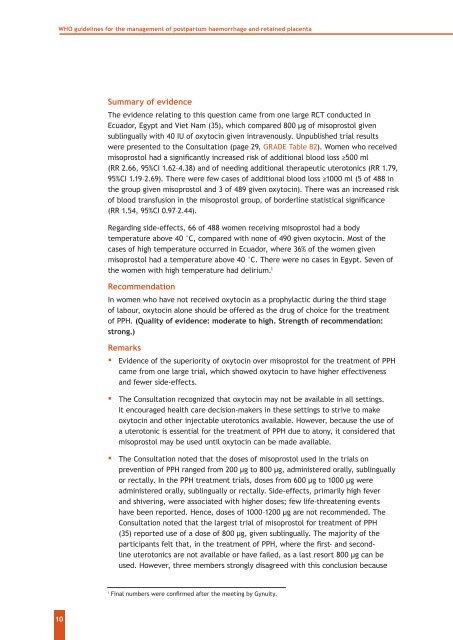WHO guidelines for the management of postpartum haemorrhage ...
WHO guidelines for the management of postpartum haemorrhage ...
WHO guidelines for the management of postpartum haemorrhage ...
Create successful ePaper yourself
Turn your PDF publications into a flip-book with our unique Google optimized e-Paper software.
<strong>WHO</strong> <strong>guidelines</strong> <strong>for</strong> <strong>the</strong> <strong>management</strong> <strong>of</strong> <strong>postpartum</strong> <strong>haemorrhage</strong> and retained placenta<br />
Summary <strong>of</strong> evidence<br />
The evidence relating to this question came from one large RCT conducted in<br />
Ecuador, Egypt and Viet Nam (35), which compared 800 µg <strong>of</strong> misoprostol given<br />
sublingually with 40 IU <strong>of</strong> oxytocin given intravenously. Unpublished trial results<br />
were presented to <strong>the</strong> Consultation (page 29, GRADE Table B2). Women who received<br />
misoprostol had a significantly increased risk <strong>of</strong> additional blood loss ≥500 ml<br />
(RR 2.66, 95%CI 1.62–4.38) and <strong>of</strong> needing additional <strong>the</strong>rapeutic uterotonics (RR 1.79,<br />
95%CI 1.19–2.69). There were few cases <strong>of</strong> additional blood loss ≥1000 ml (5 <strong>of</strong> 488 in<br />
<strong>the</strong> group given misoprostol and 3 <strong>of</strong> 489 given oxytocin). There was an increased risk<br />
<strong>of</strong> blood transfusion in <strong>the</strong> misoprostol group, <strong>of</strong> borderline statistical significance<br />
(RR 1.54, 95%CI 0.97–2.44).<br />
Regarding side-effects, 66 <strong>of</strong> 488 women receiving misoprostol had a body<br />
temperature above 40 °C, compared with none <strong>of</strong> 490 given oxytocin. Most <strong>of</strong> <strong>the</strong><br />
cases <strong>of</strong> high temperature occurred in Ecuador, where 36% <strong>of</strong> <strong>the</strong> women given<br />
misoprostol had a temperature above 40 °C. There were no cases in Egypt. Seven <strong>of</strong><br />
<strong>the</strong> women with high temperature had delirium. 1<br />
Recommendation<br />
In women who have not received oxytocin as a prophylactic during <strong>the</strong> third stage<br />
<strong>of</strong> labour, oxytocin alone should be <strong>of</strong>fered as <strong>the</strong> drug <strong>of</strong> choice <strong>for</strong> <strong>the</strong> treatment<br />
<strong>of</strong> PPH. (Quality <strong>of</strong> evidence: moderate to high. Strength <strong>of</strong> recommendation:<br />
strong.)<br />
Remarks<br />
▪ Evidence <strong>of</strong> <strong>the</strong> superiority <strong>of</strong> oxytocin over misoprostol <strong>for</strong> <strong>the</strong> treatment <strong>of</strong> PPH<br />
came from one large trial, which showed oxytocin to have higher effectiveness<br />
and fewer side-effects.<br />
▪ The Consultation recognized that oxytocin may not be available in all settings.<br />
It encouraged health care decision-makers in <strong>the</strong>se settings to strive to make<br />
oxytocin and o<strong>the</strong>r injectable uterotonics available. However, because <strong>the</strong> use <strong>of</strong><br />
a uterotonic is essential <strong>for</strong> <strong>the</strong> treatment <strong>of</strong> PPH due to atony, it considered that<br />
misoprostol may be used until oxytocin can be made available.<br />
▪ The Consultation noted that <strong>the</strong> doses <strong>of</strong> misoprostol used in <strong>the</strong> trials on<br />
prevention <strong>of</strong> PPH ranged from 200 µg to 800 µg, administered orally, sublingually<br />
or rectally. In <strong>the</strong> PPH treatment trials, doses from 600 µg to 1000 µg were<br />
administered orally, sublingually or rectally. Side-effects, primarily high fever<br />
and shivering, were associated with higher doses; few life-threatening events<br />
have been reported. Hence, doses <strong>of</strong> 1000–1200 µg are not recommended. The<br />
Consultation noted that <strong>the</strong> largest trial <strong>of</strong> misoprostol <strong>for</strong> treatment <strong>of</strong> PPH<br />
(35) reported use <strong>of</strong> a dose <strong>of</strong> 800 µg, given sublingually. The majority <strong>of</strong> <strong>the</strong><br />
participants felt that, in <strong>the</strong> treatment <strong>of</strong> PPH, where <strong>the</strong> first- and secondline<br />
uterotonics are not available or have failed, as a last resort 800 μg can be<br />
used. However, three members strongly disagreed with this conclusion because<br />
1<br />
Final numbers were confirmed after <strong>the</strong> meeting by Gynuity.<br />
10
















